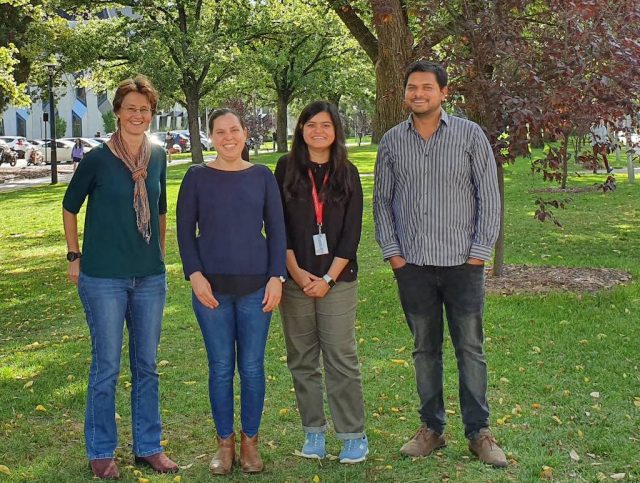Cutting-edge hydrogen research in Australia
Researchers are developing new ways to export Australia’s renewable energy in the form of hydrogen.

In 2018 ARENA provided funding to 16 projects aiming to deliver innovations at all stages of the hydrogen supply chain.
At the time, an ARENA-commissioned report provided a vision for a multi billion dollar Australian hydrogen export industry that could create thousands of Australian jobs. Achieving the vision and creating commercially viable hydrogen would require significant breakthroughs, particularly to reduce the cost of production.
Nearly two and a half years on, we checked in with some of the projects to see how they are progressing.
Hydrogen research – Ammonia from renewables
One project has set out to produce ammonia from renewable energy at ambient temperatures and pressures.
Led by Monash University in collaboration with the University of Wollongong, the process starts by using renewable energy to power an electrolyser to split water into hydrogen and oxygen. Hydrogen can then be converted to ammonia using the non-haber-bosch process.
Hydrogen can also be sourced from the atmosphere using an air separation unit at the beginning of the process.
The team has said progress has been ‘excellent’, achieving their milestones to date and improving the performance of producing ammonia from atmospheric nitrogen at ambient conditions.
They see ammonia as a leading candidate for exporting renewable energy, with established technology and supply chains already in place around the world.
“Our process is one of the most promising low cost approaches to generating ammonia directly from renewables, plus air and water. We have made great progress in the last 12 months on improving the rate of the process in our cells, essentially placing the productivity of our process in a practical and scalable zone.” Professor Doug MacFarlane said.
Their success has prompted the creation of a spin out company, Jupiter Ionics P/L, which has been funded by local high net worth families and will be a vehicle to accelerate the scaling up of their electrolysers.
Once fully scaled up, the researchers see their electrolysers being situated at wind and solar farms, absorbing DC power directly and piping hydrogen to export terminals.
“They can run on a variable load basis, allowing power to be supplied to the grid when value is high. There is also significant potential for these units to be installed at sea as part of offshore wind farms.”
“At a smaller scale the electrolyser could be used at a local scale to generate ammonia as a fertiliser for farming communities; we have had very significant interest in this application and appropriate sized units represent part of our route to the scale required for export.” Professor MacFarlane said.
Reversible storage of hydrogen in carbons
RMIT University aims to develop a system to store and transport renewable electricity as hydrogen in a dry carbon-based powder or slurry.
This would be cheaper to manage than the liquid form, allowing more hydrogen to be exported. The technology is emissions free and environmentally benign.
Testing of the novel ‘proton flow reactor’ system has shown that they are able to recover 60% of the hydrogen stored in the ‘wet to dry’ electrodes they created for the project.
Professor John Andrews from RMIT said the team has lodged an application to IP Australia for a provisional patent for this technology. He explained that the main application for their system is exporting renewable energy.
“The importing country can use the reactor working in reverse direction to generate electricity. In addition, the same system can be used for medium and grid-scale storage of renewable energy and resupply of electricity after storage,” Professor Andrews said.
They will use the remainder of the project to demonstrate the technology and work to maximise the amount of hydrogen that they can store by tailoring the composition of the carbon.
Efficient solar from hydrogen
Researchers from the Australian National University set out to simplify the process of converting solar energy into hydrogen.
Unlike existing systems that employ separate solar and electrolyser technologies, ANU is developing an integrated solar hydrogen cell that boosts efficiency and reduces infrastructure costs by eliminating the need for transmission lines, inverters and electrolysers.

So far, the team has demonstrated efficiencies of 16% using perovskite-silicon tandem cells and low cost catalysts. Their work has received international recognition, having been listed as one of the global top 10 innovations in 2020 by the Innovation for Cool Earth Forum (ICEF).
They see applications for hydrogen for grid support, transportation, high temperature heat and as a chemical feedstock, but are conscious that cost is a barrier when it is produced with renewables. They see two opportunities to reduce that cost by increasing the efficiency from solar to hydrogen and reducing balance-of-systems costs, which they are tackling with their integrated system.
“Our approach uses a unique combination of materials that allows high efficiency for each part of the conversion process. This includes careful matching of the catalyst and light absorbing materials to minimize losses. We have performed some preliminary analysis that indicates our approach has the potential to be a competitive alternative to producing hydrogen with conventional methods,” Professor Kylie Catchpole said.
By the end of the project they aim to have increased efficiency further and improved stability, as well as developing a more comprehensive comparison of costs for different methods of hydrogen production. They believe this will help to further establish the viability of their technology.
LIKE THIS STORY? SIGN UP TO OUR NEWSLETTER

ARENA